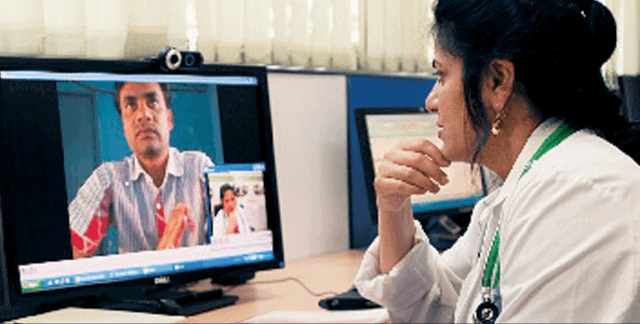Providing prompt and reliable healthcare is a challenge of massive proportions for a multitude of reasons, especially in under-developed or rural areas. The problem is a complex one and cannot be easily solved. However, thanks to recent technological advancements and breakthroughs, healthcare can become much more accessible to a greater population.
Solar steam sterilization
In 2012, researchers at Rice University revealed a new way to convert solar energy directly into steam using light-absorbing nanoparticles. The technology has been operationalised in the form of a solar steam-powered autoclave for sterilizing medical and dental equipment. At the heart of the tech are nanoparticles.
These nanoparticles heat up when submerged in water and exposed to sunlight. The heat generation is so rapid that the surrounding water instantly vaporizes to form steam. The system even works with icy-cold water and boasts an overall energy efficiency of 24% (as opposed to commercial photovoltaic solar panels that typically have an overall energy efficiency of around 15%! The heat and pressure generated by the steam have been found sufficient to kill not just heat-resistant living microbes, but also spores and viruses.
Motorcycle ambulances
Motorcycle ambulances are emergency vehicles that either carries a paramedic to a patient; or is used with a trailer or sidecar to transport patients. For obvious reasons, a motorcycle ambulance is able to respond to an emergency much faster than a four-wheeler in heavy traffic, which can drastically increase survival rates.
The concept of motorcycle ambulances is not really a new one. They first came into use during the First World War, and were used by the British, French and Americans. However, with the advancement of technology, many countries across the world started creating fleets of motorcycle ambulances, that either operate as standalone units or complement regular ambulances.
Bengaluru was the first Indian city to boast of a motorcycle ambulance in 2015. Delhi launched the project this year with 16 ambucycles, as they are often called.

Telemedicine
Telemedicine is medical care provided at a distance. Medical data is sent from patients to doctors in real-time, eliminating the need for either party to travel in person to the other. The technology was first put into practice in the 1950s in the US. Medical staff at two different health centres in Pennsylvania about 24 miles apart transmitted radiologic images via telephone. Around the same time, a Canadian doctor built upon this technology into a Tele radiology system that was used in and around Montreal. In 1959, doctors at the University of Nebraska succeeded in transmitting neurological examinations to medical students across campus using a two-way interactive television. By 1964, the technology had become sufficiently advanced to enable them to provide health services 112 miles away.
Originally, health professionals developed this technology to reach remote patients living in rural areas. However, in recent years, it has seen greater use in the urban context due to the convenience factor. Telemedicine makes up for healthcare shortages for urban populations, while also eliminating the need for a commute.
The unavailability of sufficient numbers of medical professionals has led to the rise of telemedicine companies that offer patients 24/7 access to medical care with an on-call doctor. Others provide a telemedicine platform for physicians, allowing them virtual visits with their own patients. Still others offer hospitals and larger health centres access to extra clinical staff and specialists, enabling them to outsource special cases.
With a wide variety of mobile health apps and new mobile medical devices that are consumer-friendly, patients are starting to use technology to monitor and track their health. Simple home-use medical devices that can take vitals and diagnose infections, monitor blood pressure and sugar levels are making it possible for patients to gather medical information needed for a diagnosis without going to a doctor’s office.

Sensors and wearable technology
Wearable medical devices and sensors are another way of collecting crucial medical data. Devices like the Fitbit have now become commonplace. Along with the basic functions that they perform which can often alert users to crises much before they become unmanageable, it is possible to equip patients with more advanced sensors for the period of recuperation (perhaps after a surgery) that can send an alert to a care provider if the patient falls down or detect skin pH levels to tell if a cut is getting infected.
Technology has brought the world into our homes and at our fingertips in more ways than one. While its most appreciated benefit has been greater convenience, it is undeniable that it can revolutionize lives in much more fundamental ways. In a 4G/5G world, it could be the difference between life and death. At any rate, with new advancements happening almost every other day, the potential uses in the domain of healthcare and healthcare access are far greater than we can imagine at this point.
Comments (0)
School Admission In Noida
Zoombinis: Logical Journey" challenges fourth graders at Shri Ram Universal School to solve puzzles, fostering critical thinking and problem-solving skills. Perfect for school admission in Noida , it enhances logical reasoning while immersing students in an engaging educational adventure tailored to their academic development.
Best Residential Schools in India
At Delhi Public School, known as one of the best residential schools in India , students benefit from memory-boosting foods like blueberries, almonds, spinach, eggs, and oily fish. These brain-boosting options support academic excellence and overall well-being.
Best Engineering Colleges in Punjab
Indo Global College stands out as one of the best engineering colleges in Punjab , offering quality education at an affordable fee structure. Renowned for its modern facilities, experienced faculty, and industry-aligned curriculum, it ensures an excellent learning environment for aspiring engineers.
shahbaz
Improving the quality of education in rural India is crucial for overall development. Accessible schools in Sarjapur Road and similar regions play a vital role in this endeavor. By investing in infrastructure, curriculum enhancement, and teacher training, we can empower these communities with the knowledge and skills needed for a brighter future.
springfieldschool
Thanks for sharing your blog very good and helpful . Dining Hall Springfield Public School Being one of the most prestigious CBSE Boarding Schools has never compromised on meals for students. We understand & consider nutritious meals are very important for physical and mental growth, also overall development in early life. Food habits during the initial years can influence preferences and practices in later life A healthy" Boarding School Food And Dinning Hall
Kisalay Commerce Classes
xI read your blog this is a very important blog for me. The tips you shared have made a significant difference in how I approach my studies. I appreciate the practical advice that goes beyond textbooks and classroom lectures. You can also visit: https://www.kisalaycommerceclasses.com/
akhilsharma
Nice Blog. Thanks for sharing us :)